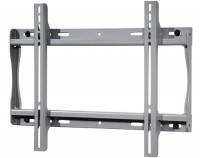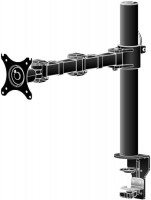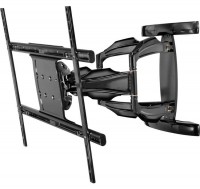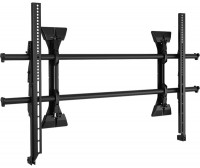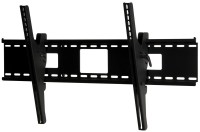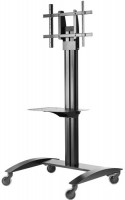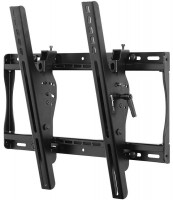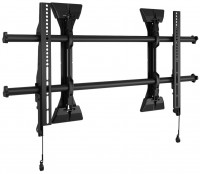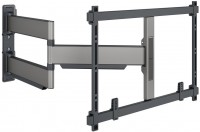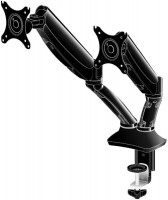TV Mounts & Stands TECHLY
All Mounts & Stands Advanced filters → |
You might be interested in
Articles, reviews, useful tips
All materials
TOP devices for a home with pets
Household appliances that will help you get rid of hair, purify and humidify the air and spy on your pet

Chinese TVs: A Guide to Leading Brands
Chinese TV brands are gaining popularity
TV Mounts & Stands: specifications, types
Type
— Wall mount. Device for attaching the TV to the wall; it attaches directly to the surface, without additional items. Such an installation will be especially useful in small rooms where the area does not allow the use of a floor stand. However mounting to the wall requires certain labor costs (for example, a concrete wall will have to be drilled).
— Ceiling mount. Device for attaching the TV to the ceiling. As well as wall-mounted, it does not require additional equipment, pieces of furniture, etc., and allows you to save space, however, installation is associated with some difficulties, and it is inconvenient to constantly watch TV with your head up. Therefore, such a mount is designed primarily for public places, where it is important to protect equipment from theft and vandalism.
— Desktop mount. Device for mounting the screen on a table or similar surface. The specific installation method may be different: among desktop models, there are both stands without additional clamps, and stands with clamps and/or bolt-through fastening (see "Installation"). However, anyway, desktop models are intended mainly for monitors — in cases where their own stand is either completely absent in the design, or does not fit in one way or another.
— Floor mount. Stand designed for installation on the floor. Usually it is not rig...idly fixed, it can be rearranged if desired, there are even models with wheels. Unlike various stands (see below), it is designed primarily to accommodate a TV, and any additional shelves are the exception rather than the rule. The advantage of floor mounts is ease of installation, the disadvantage is the need for space on the floor.
— Stand. The stand in this case is a separate piece of furniture with one or more shelves, and sometimes even drawers. The TV on the stand is installed on the top shelf on its own stand, and the remaining shelves can be used to place additional equipment (for example, a DVD player or media centre) or other items. Such stands are as simple as possible to install and use — they are simply placed on the floor, like ordinary tables. They also have practically no compatibility problems: the working part is a regular flat surface suitable for any complete stand (within certain dimensions and weight, of course). The main disadvantage is the space occupied on the floor, due to which the stands are poorly suited for tight spaces. In addition, installing a TV on its own stand is somewhat less reliable than on a mount, because. there is a possibility of overturning (albeit very small).
— Stand with mount. A kind of stand (see above), equipped with its own TV mount. Retaining most of the advantages of classic stands (easy to install, additional shelves), this design provides increased reliability — you can overturn the TV only together with the cabinet, which is almost impossible to do by accident. At the same time, the presence of a mount reduces versatility compared to conventional stands — not every TV can fit under it.
— For CRT TVs. As the name suggests, these stands are designed for older TV sets based on kinescopes (CRTs). Unlike LCD-models, such TVs have a significant thickness (comparable to the screen size) and corresponding weight, and also usually do not have their own mounting devices and are installed only on a flat surface. Stands for them have the appropriate dimensions and maximum load. Today they are rare, due to the decline in the popularity of CRT.
— For DVD players. As the name implies, these stands are designed to install DVD players, media centers and other similar auxiliary electronics. Usually, they have the simplest design: a minimum of adjustments (except for height adjustment), one, in extreme cases two, shelves; and the maximum load rarely exceeds 20 kg. Technically, a TV can also be placed on such a shelf, but this is much less convenient than using a specialized TV stand.
— Ceiling mount. Device for attaching the TV to the ceiling. As well as wall-mounted, it does not require additional equipment, pieces of furniture, etc., and allows you to save space, however, installation is associated with some difficulties, and it is inconvenient to constantly watch TV with your head up. Therefore, such a mount is designed primarily for public places, where it is important to protect equipment from theft and vandalism.
— Desktop mount. Device for mounting the screen on a table or similar surface. The specific installation method may be different: among desktop models, there are both stands without additional clamps, and stands with clamps and/or bolt-through fastening (see "Installation"). However, anyway, desktop models are intended mainly for monitors — in cases where their own stand is either completely absent in the design, or does not fit in one way or another.
— Floor mount. Stand designed for installation on the floor. Usually it is not rig...idly fixed, it can be rearranged if desired, there are even models with wheels. Unlike various stands (see below), it is designed primarily to accommodate a TV, and any additional shelves are the exception rather than the rule. The advantage of floor mounts is ease of installation, the disadvantage is the need for space on the floor.
— Stand. The stand in this case is a separate piece of furniture with one or more shelves, and sometimes even drawers. The TV on the stand is installed on the top shelf on its own stand, and the remaining shelves can be used to place additional equipment (for example, a DVD player or media centre) or other items. Such stands are as simple as possible to install and use — they are simply placed on the floor, like ordinary tables. They also have practically no compatibility problems: the working part is a regular flat surface suitable for any complete stand (within certain dimensions and weight, of course). The main disadvantage is the space occupied on the floor, due to which the stands are poorly suited for tight spaces. In addition, installing a TV on its own stand is somewhat less reliable than on a mount, because. there is a possibility of overturning (albeit very small).
— Stand with mount. A kind of stand (see above), equipped with its own TV mount. Retaining most of the advantages of classic stands (easy to install, additional shelves), this design provides increased reliability — you can overturn the TV only together with the cabinet, which is almost impossible to do by accident. At the same time, the presence of a mount reduces versatility compared to conventional stands — not every TV can fit under it.
— For CRT TVs. As the name suggests, these stands are designed for older TV sets based on kinescopes (CRTs). Unlike LCD-models, such TVs have a significant thickness (comparable to the screen size) and corresponding weight, and also usually do not have their own mounting devices and are installed only on a flat surface. Stands for them have the appropriate dimensions and maximum load. Today they are rare, due to the decline in the popularity of CRT.
— For DVD players. As the name implies, these stands are designed to install DVD players, media centers and other similar auxiliary electronics. Usually, they have the simplest design: a minimum of adjustments (except for height adjustment), one, in extreme cases two, shelves; and the maximum load rarely exceeds 20 kg. Technically, a TV can also be placed on such a shelf, but this is much less convenient than using a specialized TV stand.
Number of mounts
The number of mounts for TVs provided in the design of the stand. Most modern stands have one mount — after all, most often TVs are used as a single device, and this is quite enough. However, there are models on which you can install more TVs — up to 6. This allows you to create a "wall" of several screens put together.
In addition, there are options for 2 mounts, where TVs are installed "back to back", with screens in different directions; they are usually of the ceiling type (see above). The area of application for such mounts is primarily public places where public address systems are used: waiting rooms of railway stations and airports, large shopping centers, etc.
The most advanced models offer 3 or 4 mounts, mainly for creating "video walls" of monitors.
Note that in our catalog this parameter is indicated only for models with two or more mounts; if it is not specified, it means that there is only one mount.
In addition, there are options for 2 mounts, where TVs are installed "back to back", with screens in different directions; they are usually of the ceiling type (see above). The area of application for such mounts is primarily public places where public address systems are used: waiting rooms of railway stations and airports, large shopping centers, etc.
The most advanced models offer 3 or 4 mounts, mainly for creating "video walls" of monitors.
Note that in our catalog this parameter is indicated only for models with two or more mounts; if it is not specified, it means that there is only one mount.
Installation
Method of table mount installation (see "Type") to the tabletop.
This parameter is specified for those models that have additional devices for fixing on the table — a clamp, a platform for bolt-through mounting, or both. In addition, there are ordinary stands that do not have fixing devices; they are as simple as possible to install and move from place to place, but they are not very reliable.
As for the different installation methods, their features are as follows:
— Clamp. Fixation with a clamp attached to the edge of the table. Clamps are more limited in their choice of mounting location than bolts — such a mount cannot be installed in the middle of a countertop. At the same time, such installation is much easier both during the initial installation and when moving the structure from place to place: there is no need to drill a table, preparing a place for bolts. And the limited choice of location is often compensated by an abundance of adjustments that allow you to set the optimal position of the screen. Due to this, clamps are the most popular in desktop mounts.
— Bolt-through mounting. Mounting with bolts through holes in the countertop. The main advantages of this option are reliability, as well as the ability to choose the installation point almost anywhere on the countertop. On the other hand, the installation procedure itself...is quite complicated and involves permanent placement in one place, without moving — after all, it is necessary to drill holes for the bolts. Therefore, such a method of installation in its pure form is extremely rare nowadays — universal mounts have become more common (see below).
— Universal. Mounts that allows two mounting options described above at once — using a clamp to the edge of the countertop or using bolts. This design allows you to choose the best option. At the same time, it is technically easy to provide both a clamp and the possibility of bolt-through installation in one mount; therefore, most mounts with the possibility of using bolts are universal.
This parameter is specified for those models that have additional devices for fixing on the table — a clamp, a platform for bolt-through mounting, or both. In addition, there are ordinary stands that do not have fixing devices; they are as simple as possible to install and move from place to place, but they are not very reliable.
As for the different installation methods, their features are as follows:
— Clamp. Fixation with a clamp attached to the edge of the table. Clamps are more limited in their choice of mounting location than bolts — such a mount cannot be installed in the middle of a countertop. At the same time, such installation is much easier both during the initial installation and when moving the structure from place to place: there is no need to drill a table, preparing a place for bolts. And the limited choice of location is often compensated by an abundance of adjustments that allow you to set the optimal position of the screen. Due to this, clamps are the most popular in desktop mounts.
— Bolt-through mounting. Mounting with bolts through holes in the countertop. The main advantages of this option are reliability, as well as the ability to choose the installation point almost anywhere on the countertop. On the other hand, the installation procedure itself...is quite complicated and involves permanent placement in one place, without moving — after all, it is necessary to drill holes for the bolts. Therefore, such a method of installation in its pure form is extremely rare nowadays — universal mounts have become more common (see below).
— Universal. Mounts that allows two mounting options described above at once — using a clamp to the edge of the countertop or using bolts. This design allows you to choose the best option. At the same time, it is technically easy to provide both a clamp and the possibility of bolt-through installation in one mount; therefore, most mounts with the possibility of using bolts are universal.
Stand design
— Standard. Stands in a classic design, primarily for installation along the wall; usually have a design that allows them to be installed also in the middle of the room.
— Corner. Corner stand, as the name suggests, is designed to be installed in a corner and has an appropriate shape. In some rooms, this installation may be optimal due to the size and characteristics of the situation. Technically, a corner stand can also be placed in the middle of the room, but such an installation will not always be optimal in terms of design.
— Corner. Corner stand, as the name suggests, is designed to be installed in a corner and has an appropriate shape. In some rooms, this installation may be optimal due to the size and characteristics of the situation. Technically, a corner stand can also be placed in the middle of the room, but such an installation will not always be optimal in terms of design.
Built-in speaker
A full-fledged speaker system originally built into a TV stand. The specifications of this system directly depends on the specific product. So, it can be either a simple two-speaker stereo system, or an advanced solution with several speakers of various types, a built-in subwoofer, an integrated control panel, support for numerous modern sound generation technologies (pay attention to the description of each individual model ). Anyway, such a stand relieves the user of the need to buy a separate acoustic system, on the one hand, and on the other hand, it allows to solve the problem of placing the system and integrating it into the overall design.
Minimum size
The minimum TV screen size that can be mounted on the stand/mount. It is usually indicated for structures with mounts, for stands this parameter is irrelevant (for more details, see "Type"). The parameter is not absolutely accurate, because technically, TVs with a smaller size can fit the mount; however, in general, it allows to evaluate the scope of a particular model of mount/stand.
Max. size
The maximum size of the TV screen that can be installed on the stand/mount. Like the minimum size (see above), it is in some way a conditional indicator — TVs with a larger size can also fit for the mount, and then the main determining parameter will be the maximum weight (see below).
Max. weight
The maximum weight of the TV that can be installed on the mount/stand; more specifically, it is the maximum weight that the mount/stand can support for an indefinitely long time without any negative consequences. Unlike the screen size described above, this parameter is accurate and should not be exceeded: perhaps the stand/mount will not break immediately under excess weight, but this can happen at any time, and such a breakdown is not covered by the warranty.
It is worth considering that for classic stands with several shelves (see "Type"), the maximum wheight is usually indicated for the entire structure as a whole and is the sum of the loads for each individual shelf. Thus, the maximum weight of the TV is not limited by the total maximum wheight, but by the maximum wheight for one shelf. This does not apply to stands with mounts; they usually list the maximum wheight on the mount, in which case it corresponds to the maximum weight of the TV.
The screen size is directly related to the maximum wheight (after all, a large TV weighs more). Typically, for screens up to 24", structures with a maximum wheight of about 5-6 kg are usually quite enough, for a 32" device, about 12 kg may be needed, large 55" screens reach a maximum weight of about 25-30 kg, and in the case of plasma panels, these figures increase by 1.5-2 times However, anyway, before choosing, you should clarify the weight of the specific TV model for which the stand/mount is selected.
It is worth considering that for classic stands with several shelves (see "Type"), the maximum wheight is usually indicated for the entire structure as a whole and is the sum of the loads for each individual shelf. Thus, the maximum weight of the TV is not limited by the total maximum wheight, but by the maximum wheight for one shelf. This does not apply to stands with mounts; they usually list the maximum wheight on the mount, in which case it corresponds to the maximum weight of the TV.
The screen size is directly related to the maximum wheight (after all, a large TV weighs more). Typically, for screens up to 24", structures with a maximum wheight of about 5-6 kg are usually quite enough, for a 32" device, about 12 kg may be needed, large 55" screens reach a maximum weight of about 25-30 kg, and in the case of plasma panels, these figures increase by 1.5-2 times However, anyway, before choosing, you should clarify the weight of the specific TV model for which the stand/mount is selected.
Number of shelves
The number of open shelves provided in the design of the stand/mount. These shelves can be used both for additional electronics (media centers, game consoles, satellite receivers, sound systems…), as well as for other items, from movies on discs to decorative items, souvenirs, etc. And in the classic stands, the TV itself is installed on the shelf. Most often there are stands with 3 open shelves, less often with 2 shelves and 1 shelf, but such options are usually supplemented with closed compartments and drawers. There are also stands with many shelves(4 or more).
Max. weight for one shelf
The maximum weight that one shelf of a stand/mount can support for an indefinitely long time without negative consequences. In stands (see "Type"), this parameter limits the maximum weight of the installed TV; see "Maximum weight" for details.
Distance between shelves
The distance between the shelves of the stand/mount in height determines the maximum dimensions of the items that can be placed there. Media centers, satellite receivers, etc. usually have a small thickness and can be placed on almost any shelf without any problems, but if you want to install a home theater subwoofer on the stand, you should clarify not only its weight, but also the correspondence of the dimensions to the distance between the shelves.
Drawers
Number of drawers provided in the design of the product.
Drawers are convenient for storing relatively small items which you need to keep in close proximity to the screen. Typical examples are various cables and adapters, as well as electronics documentation. To install drawers, you need a fairly large amount of free space, and therefore they are found mainly in stands of one kind or another (see "Type").
Drawers are convenient for storing relatively small items which you need to keep in close proximity to the screen. Typical examples are various cables and adapters, as well as electronics documentation. To install drawers, you need a fairly large amount of free space, and therefore they are found mainly in stands of one kind or another (see "Type").
Closed compartments
The number of closed compartments provided in the design of the product. In this case, a closed compartment means a compartment covered with a hinged or sliding door; the number of such compartments is indicated by the total number of doors.
These compartments are usually quite high, making them suitable for fairly large items (such as an entire collection of DVDs or Blu-ray discs). And it makes sense to provide such equipment, first of all, in stands of one kind or another (see "Type").
These compartments are usually quite high, making them suitable for fairly large items (such as an entire collection of DVDs or Blu-ray discs). And it makes sense to provide such equipment, first of all, in stands of one kind or another (see "Type").
Minimum distance from the wall
The smallest possible distance between the wall on which the mount is hung and its farthest protruding point. First of all, the overall compactness of the design depends on the minimum distance: if you do not want the TV to protrude far forward from the wall, you should pay attention to models with a small minimum distance. And if the mount provides length adjustment, this parameter determines the limits of such adjustment.
Max. distance from wall
The maximum distance from the TV mounting point to the wall (in the case of ceiling mounts, to the ceiling) provided by the mount. See "Minimum distance from wall" for details.
Minimum distance from ceiling
The minimum distance from the ceiling to the mounting point of the TV that the mount can provide, in other words, the highest point where the TV can be placed on the mount. It is one of the indicators of the mobility of the installed TV. Specified for ceiling models (see "Type").
Max. distance from ceiling
The maximum distance from the ceiling to the fixing point of the TV, provided by the design of the mount. Specified for ceiling models. Unlike the minimum distance to the ceiling (see above), it is not only an indicator of the mobility of the TV, but also a certain limiter in terms of screen size: large-sized TV models may simply not fit between the ceiling and the fixing point, even if they fit the other indicators. Solve this problem by adjusting the tilt, if such a possibility is provided (see "Adjustments").
Adjustments
The ability to change the position of the TV installed on the mount. Adjustments make it possible to optimally adjust the location of the screen; the more there are adjustments, the wider the customization options.
— For curved TVs. Stands designed for use with curved TVs. Such TVs are becoming increasingly popular — it is believed that the curved shape has a positive effect on the image quality. Note that the dimensions and curvature of such screens can be different, so the compatibility of the stand with a specific TV has to be clarified separately.
— Tilt. The ability to adjust the tilt of the installed TV forward and backward relative to the vertical position. It will be useful if the TV is not installed at eye level, and also if the height of the audience changes (for example, if you are sitting on the sofa, then on the floor, depending on your mood).
— Turn. The ability to turn the TV around a vertical axis, from side to side. This gives a certain freedom in moving around the room — by moving to another point, you can turn the TV in the right direction and watch comfortably.
— Depth adjustment. The ability to move the TV back and forth relative to the point of attachment to the wall without changing the angle of the screen. Can be used in combination with turn — for example, if at a selected...point in the room an object on the side of the TV is blocking it, the screen can be pulled out from behind the obstruction and turned for the optimal viewing angle.
— Slide. The ability to move the TV from side to side relative to the point of attachment to the wall without changing the angle of the screen. This can be useful, for example, when rearranging: by moving the TV to the side, you can install a piece of furniture next to it that did not fit there before, without rearranging the mount itself. It can also be used in conjunction with turn, similar to depth adjustment (see above).
— Rotation. The ability to rotate the installed monitor around the horizontal axis, in other words, the ability to rotate the screen from a horizontal position (“landscape” orientation) to a vertical (“portrait”) one. In everyday use, this function is practically not in demand, and therefore is rare. At the same time, it can be useful for specialized purposes — for example, if the screen is used as a monitor and you need to work with vertically stretched materials (graphics or texts).
— Height adjustment. The ability to adjust the height of the TV on the mount. Allows you to optimally adjust the position of the screen relative to eye level, surrounding objects, etc.
— For curved TVs. Stands designed for use with curved TVs. Such TVs are becoming increasingly popular — it is believed that the curved shape has a positive effect on the image quality. Note that the dimensions and curvature of such screens can be different, so the compatibility of the stand with a specific TV has to be clarified separately.
— Tilt. The ability to adjust the tilt of the installed TV forward and backward relative to the vertical position. It will be useful if the TV is not installed at eye level, and also if the height of the audience changes (for example, if you are sitting on the sofa, then on the floor, depending on your mood).
— Turn. The ability to turn the TV around a vertical axis, from side to side. This gives a certain freedom in moving around the room — by moving to another point, you can turn the TV in the right direction and watch comfortably.
— Depth adjustment. The ability to move the TV back and forth relative to the point of attachment to the wall without changing the angle of the screen. Can be used in combination with turn — for example, if at a selected...point in the room an object on the side of the TV is blocking it, the screen can be pulled out from behind the obstruction and turned for the optimal viewing angle.
— Slide. The ability to move the TV from side to side relative to the point of attachment to the wall without changing the angle of the screen. This can be useful, for example, when rearranging: by moving the TV to the side, you can install a piece of furniture next to it that did not fit there before, without rearranging the mount itself. It can also be used in conjunction with turn, similar to depth adjustment (see above).
— Rotation. The ability to rotate the installed monitor around the horizontal axis, in other words, the ability to rotate the screen from a horizontal position (“landscape” orientation) to a vertical (“portrait”) one. In everyday use, this function is practically not in demand, and therefore is rare. At the same time, it can be useful for specialized purposes — for example, if the screen is used as a monitor and you need to work with vertically stretched materials (graphics or texts).
— Height adjustment. The ability to adjust the height of the TV on the mount. Allows you to optimally adjust the position of the screen relative to eye level, surrounding objects, etc.
Built-in level
The presence of a water level on the body of the device greatly facilitates the installation of a wall mount, helping to hang the TV mount perfectly straight.
Upward tilt angle
The maximum upwards tilt angle from the vertical of the installed screen. The larger the tilt angle, the wider the adjustment possibilities, however, in fact, an angle of more than 5° is rarely required.
Downward tilt angle
The maximum downward tilt angle from the vertical for the installed screen. As with the upward tilt angle, the larger this angle, the wider the adjustment possibilities; however, downward tilt is usually required more frequently (the TV may be installed under the ceiling), and its angle can be as high as 15-20°.
Turn angle
The angle within which the screen installed on the mount can rotate. Measured from far left to far right. In modern models, it can reach 180°.
Rotation angle
The angle within which the screen installed on the mount can rotate. Rotation refers to turning around a horizontal axis perpendicular to the screen; see "Adjustments" for details. And the angle is usually indicated from one extreme position to another.
According to this parameter, two categories of mounts can be distinguished. In one of them, the rotation angle is small — about 10 – 15 ° — and this feature is mainly intended to compensate for inaccuracies made during the installation of the structure: even if the mount hangs slightly unevenly, rotation allows you to set the screen straight. The second variety is models with a rotation angle of 180° and above (up to 360°); they allow user to rotate the screen from landscape to portrait and vice versa.
According to this parameter, two categories of mounts can be distinguished. In one of them, the rotation angle is small — about 10 – 15 ° — and this feature is mainly intended to compensate for inaccuracies made during the installation of the structure: even if the mount hangs slightly unevenly, rotation allows you to set the screen straight. The second variety is models with a rotation angle of 180° and above (up to 360°); they allow user to rotate the screen from landscape to portrait and vice versa.
VESA
VESA is generally accepted standard for most modern screens (TVs, monitors, plasma panels) and is found in all types of stands/mounts, except for classic stands (see "Type"), where the TV is placed on its own stand. Any such mount has 4 screws arranged in the shape of a rectangle (square). However, the size of this rectangle can be different, it depends primarily on the weight, and, accordingly, the size of the screen. The smallest mount today is 50x50 mm, it is designed for very miniature models; 100x100 mm can already hold TVs of about 24", 200x200 mm — 32", and in larger models, the size of the mount can reach 800x400 mm. Many mount/stand models have holes for several VESA standards.
The following sizes of VESA mounts are currently on the market: 50x50 mm, 75x75 mm, 100x100 mm, 100x200 mm, 200x100 mm, 200x200 mm, 200x300 mm, 200x400 mm, 300x200 mm, 300x300 mm, 300x400 mm, 400x200 mm , 400x300 mm, 400x400 mm, 500x400 mm, 600x400 mm, 600x600 mm, 700x400 mm, 800x400 mm, 800x600 mm, 800x800 mm, 900x400 mm, 900x500 mm, 900x600 mm, 1000x500 mm, 1000x600 mm.
The following sizes of VESA mounts are currently on the market: 50x50 mm, 75x75 mm, 100x100 mm, 100x200 mm, 200x100 mm, 200x200 mm, 200x300 mm, 200x400 mm, 300x200 mm, 300x300 mm, 300x400 mm, 400x200 mm , 400x300 mm, 400x400 mm, 500x400 mm, 600x400 mm, 600x600 mm, 700x400 mm, 800x400 mm, 800x600 mm, 800x800 mm, 900x400 mm, 900x500 mm, 900x600 mm, 1000x500 mm, 1000x600 mm.
USB hub
A set of additional USB ports provided in the design of the stand or mount. Brackets with a USB hub allow you to covertly lay wires, they are also used to connect flash drives and various peripherals. In some cases, the hub has an autonomous power source, so you can power all kinds of USB gadgets from it. Typically, a USB hub includes two or four USB 3.2 gen1 ports.
Cable management
Possibility of placing the cables connected to the TV inside the rod or support of the mount(for ceiling and floor structures, respectively, see "Type"). This placement gives the whole structure a neat appearance, because cables, often of different sizes and colours, and even tangled with each other, are hidden from view and do not spoil the aesthetics.
Transportation wheels
A feature only found on floor models — such type of mounts, and stands (see "Type"). Wheels make it much easier to move the stand over short distances — within a room or to another room in the same building: they allow you to roll the structure instead of carrying it, and this allows you to spend less effort and manage the task with the forces of one person, even where several would be needed for carrying.
Stand material
In this case, a stand means a support (supports) on which the shelves of the stand are located (see "Type"). In modern stands/mounts, the following materials can be used:
— Plastic. Plastic is inexpensive and can be processed well, but its strength is rather low for the wheits that the supports in the stands should be designed for. As a result, it is very rare.
— Metal. The most common material for supports in stands: at a relatively low cost, the metal is very durable and looks stylish.
— Wood. Wood can be attributed to stylish materials: it gives the structure a solid appearance, but for a number of reasons it is quite expensive.
— Glass. Glass in the case of TV stands is a premium material: such models have a solid and rich appearance, but their cost usually matches this appearance. The disadvantages of glass are considered to be brittleness and relatively low strength, however, in many designs, thick glass with a special composition is used, as well as individual metal parts of the frame, which makes it possible to significantly compensate for these shortcomings.
— Plastic. Plastic is inexpensive and can be processed well, but its strength is rather low for the wheits that the supports in the stands should be designed for. As a result, it is very rare.
— Metal. The most common material for supports in stands: at a relatively low cost, the metal is very durable and looks stylish.
— Wood. Wood can be attributed to stylish materials: it gives the structure a solid appearance, but for a number of reasons it is quite expensive.
— Glass. Glass in the case of TV stands is a premium material: such models have a solid and rich appearance, but their cost usually matches this appearance. The disadvantages of glass are considered to be brittleness and relatively low strength, however, in many designs, thick glass with a special composition is used, as well as individual metal parts of the frame, which makes it possible to significantly compensate for these shortcomings.
Shelf material
The material from which the individual shelves in the stand are made.
— Glass. Perhaps the most popular option, found in stands and mounts from almost any material (see above). The glass has a stylish appearance, while it is easy to clean and resists scratches well. However such a shelf can break from a strong hit; however, rather thick and/or impact-resistant glasses are most often used in the design, which reduces the likelihood of such a nuisance to almost zero (at least if you do not specifically aim to break the shelf).
— Wood. Somewhat less popular than glass, but still quite practical and, as a result, a common shelf material. Note that if glass is found mainly in modern and high-tech models, then wooden shelves usually give the structure a more “warm” and traditional look.
— Plastic. Plastic is characterized, on the one hand, by low cost and availability, on the other hand, by very limited strength indicators. Because of this, these shelves are found mainly in DVD player stands(see "Type").
— Steel. Steel shelves are extremely durable and reliable, but they are not cheap. As a result, this option is typical for premium models.
— Glass. Perhaps the most popular option, found in stands and mounts from almost any material (see above). The glass has a stylish appearance, while it is easy to clean and resists scratches well. However such a shelf can break from a strong hit; however, rather thick and/or impact-resistant glasses are most often used in the design, which reduces the likelihood of such a nuisance to almost zero (at least if you do not specifically aim to break the shelf).
— Wood. Somewhat less popular than glass, but still quite practical and, as a result, a common shelf material. Note that if glass is found mainly in modern and high-tech models, then wooden shelves usually give the structure a more “warm” and traditional look.
— Plastic. Plastic is characterized, on the one hand, by low cost and availability, on the other hand, by very limited strength indicators. Because of this, these shelves are found mainly in DVD player stands(see "Type").
— Steel. Steel shelves are extremely durable and reliable, but they are not cheap. As a result, this option is typical for premium models.
Shelf thickness
The thickness of the shelves provided in the stand. With the same material (see above), thicker shelves have more strength, but weigh more and cost more.

